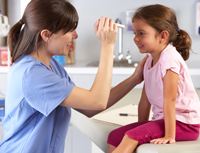|
 Back-to-school checklist should include child eye exams
Back-to-school checklist should include child eye exams
By Benjamin Kramer, MD, pediatric ophthalmologist at Horizon Eye Care
As families gear up for fall, children’s eye care is often forgotten amid the back-to-school frenzy. But academic performance can suffer when children struggle to read or cannot distinguish small text on smart boards. Parents should learn about their kids’ visual development to maximize their chance for success.
Most of the intricate connections between a child’s eyes and brain develop during the first seven years of life. Screening tests by pediatricians and schools are designed to detect vision-threatening conditions during this critical period. No screening system is perfect, though. For older children whose poor vision went undetected, frequently it is discovered too late for effective treatment.
Parents can be sure their child is developing normal vision by taking them to a pediatric ophthalmologist for a comprehensive examination. If there is a family history of glasses at an early age, eye misalignment (strabismus) or lazy eye (amblyopia), then an exam is especially recommended. Treatment usually involves just glasses or occasional eye patching, but the earlier it’s started, the better.
 Children may be anxious about seeing an eye doctor, but the assessment consists mostly of play activities designed to check visual function. After a few minutes of matching games, cartoons and flashing toys, kids will usually look forward to any return visits. Eye drops are also a critical part of the pediatric eye exam, allowing the ophthalmologist to see the internal ocular structures, and determine if glasses are needed. Most eye drops contain a numbing medication, so any stinging sensation only lasts a few seconds. Children may be anxious about seeing an eye doctor, but the assessment consists mostly of play activities designed to check visual function. After a few minutes of matching games, cartoons and flashing toys, kids will usually look forward to any return visits. Eye drops are also a critical part of the pediatric eye exam, allowing the ophthalmologist to see the internal ocular structures, and determine if glasses are needed. Most eye drops contain a numbing medication, so any stinging sensation only lasts a few seconds.
In addition to seeing a pediatric ophthalmologist, parents can take some simple steps to protect their children’s vision. Eye trauma is a leading cause of childhood vision loss, and safety glasses effectively eliminate this risk. Eye protection is particularly important with paintball, Airsoft guns and sports with balls smaller than a baseball, but any sport with physical contact can lead to eye injury and permanent vision loss. If children spend a lot of time outdoors, UVA and UVB protection with sunglasses and a brimmed hat also help ensure long-term eye health.
Many parents wonder how constant exposure to today’s technology affects their children’s eyes. In particular, they ask about standing close to the television and constantly gazing into a smartphone or tablet. Fortunately, no solid evidence exists linking prolonged exposure to these devices with any negative impact on eye health. Some authorities even recommend video games to engage children’s visual system while treating lazy eye. There is a weak association between near-sightedness and extended focusing on anything up close, though, so kids should spend as much time as possible outside. Even if the eyes don’t benefit from the outdoor activity, plenty of other body parts do.
As the back-to-school season starts, please remember that the most important gift some children need is a simple pair of glasses. Contact a pediatric ophthalmologist, and ensure your child a lifetime of clear vision.
Find a pediatric ophthalmologist near you |

